Volkswagen Touran Service Manual: Aqua Premium System, Touch-Up System for Two Layer Colors
| Product Description/Objective |
| To achieve an optically flawless color shade transition in
the blended area or adjacent parts, for example fender/door. |
| For plastic surfaces prime with Glazing Adhesion Promoter -
ALO 822 000 10- and rework with elastified Two-part HS. |
|
|
|
| Pre-treatment of base surfaces: |
| |
Clean the factory or old paint or two-part HS filler
thoroughly with Silicone Remover -LVM 020 000 A5- or Silicone
Remover, Long -LVM 020 100 A5-. |
|
|
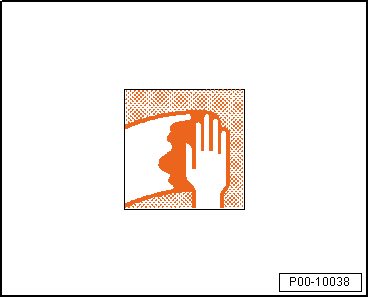
|
| |
Sand the repair area with P500-P600 grit sandpaper or
wet-sand with water-resistant P800-1000 sandpaper. |
|
|
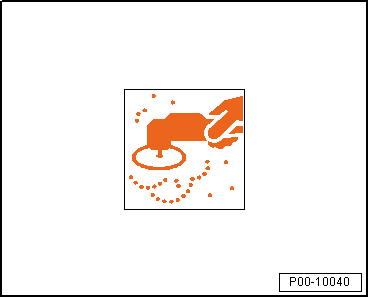
|
| |
Sand the adjacent area (around the vehicle parts and the
repair area) thoroughly with P1000-3000 sandpaper, only wet
sand. |
 Note
| If beading, edges or grip recesses are present, use a
sanding pad beforehand. |
|
|
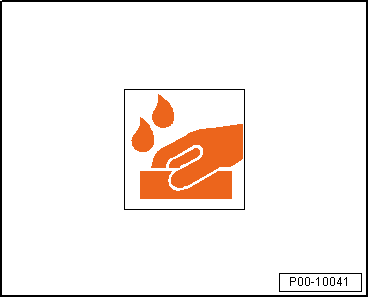
|
| |
Clean the entire surface thoroughly with Silicone Remover -LVM
020 000 A5- to remove dust, sanding residue and other dirt. |
| |
Wipe off any residual silicone remover with a lint-free
cloth, leaving no streaks. |
|
|

|
| |
Allow wet-sanded surfaces and cleaned surfaces to dry
completely. |
| When using a dust extraction, use next generation towels
with an effective light adhesive formula to minimize the risk of
chemical or adhesive residue (for example, Dust Cloth
-VAS6177-). Refer to
→ Chapter "Dust Cloth -VAS6177-". |
| Insulate sanded-through areas with Two-Part Wash Primer -LHV
043 000 A2- and then fill with Two-Part HS Performance Filler. |
|
|
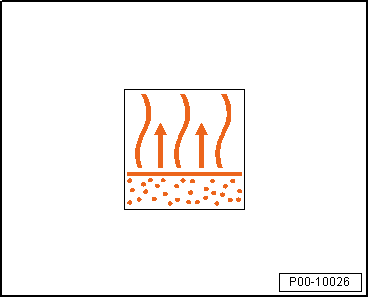
|
| Repair process, touch-up the neighboring surfaces (for
example color matching fender/door) |
| |
Apply 1-2 preliminary spray applications of the Touch-Up
Additive For Aqua Premium -LVM 035 100 A3--2-
in the blended area with normal spray pressure on the old
paint/filled surface -1-. |
 Note
| Pay attention that the blended area is large enough. |
|
|
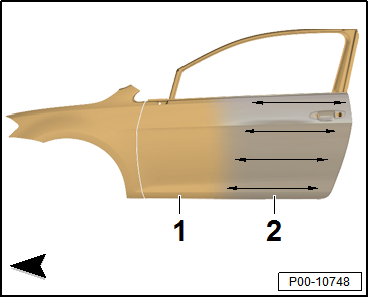
|
| |
Then the first base paint spray application
-1- is lightly applied from the
blended area into the wet touch-up additive
-2-. |
|
|
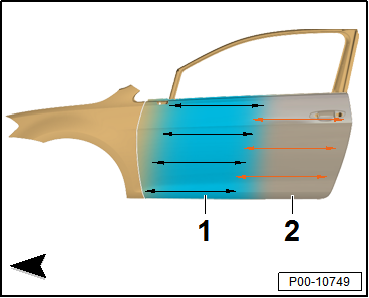
|
| |
In the second step a further reduced spray application
-2- follows without a drying time.
Pay attention that the spray application is applied in the area
previously shifted forward -1- to
archive an even effect. |
|
|
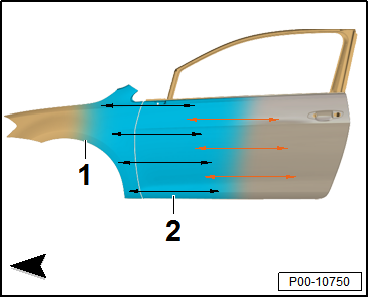
|
| |
After the touch-up painting the connection area and the
remaining surfaces (starting from the new part)
-1- in 1.5 spray applications
(standard process) are painted. |
|
|
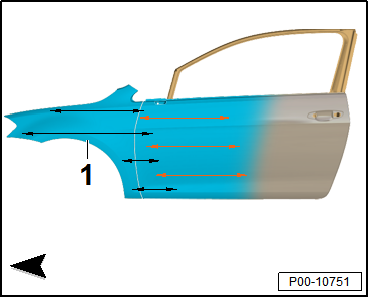
|
| |
After ventilating, apply a two-part HS clear coat
-1- over the entire repair surface. |
|
|
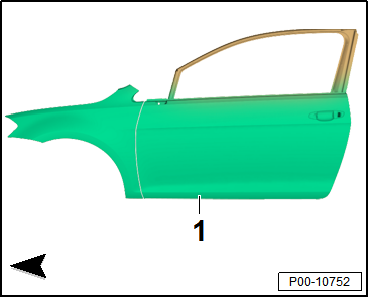
|
| Repair process, touch-up the neighboring surfaces (for
example color matching fender/door, alternative method for solid
and dark effect color shades). |
| |
Apply 1-2 preliminary spray applications of the Touch-Up
Additive For Aqua Premium -LVM 035 100 A3--2-
in the blended area with normal spray pressure on the old
paint/filled surface -1-. |
 Note
| Pay attention that the blended area is large enough. |
|
|

|
| |
Then apply the first base paint spray application
-3- from the blended area (starting
from the new part) to the edge of the wet touch-up additive
-2-. Immediately after that, apply
the half effect/finish spray application onto the wet touch-up
additive -2- and to the new part
-1-, from a distance. |
|
|
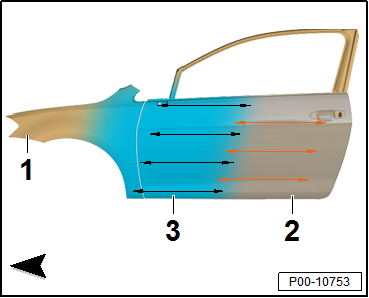
|
| |
After touch-up painting the base paint application
-1- takes place on the remaining
surfaces in 1.5 spray applications (standard process). |
|
|
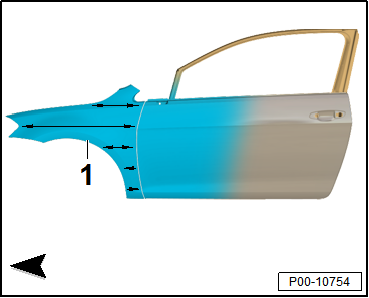
|
| |
After ventilating, apply a two-part HS clear coat
-1- over the entire repair surface. |
 Note
| Starting with the first spray application, it is recommended
to even out the subsequent repair area spray applications
starting from the touch-up area that is farthest out. For that
reason, the subsequent spray applications should always be
remain inside the previous spray application in order to archive
an even effect. |
| While processing the Aqua premium water-based base paint,
the spray gun material flow/trigger remains completely open. |
| The spraying pressure for the effect spray application can
vary between 1.5 and 2.0 bar depending on the size of the
object. |
|
|

|
| Repair process, touching-up minimal damage for example
clever repair. |
 Note
| The repair/filler area should be kept as small as possible. |
| For most colors, use the adjusted water-based base paint. |
| It is recommended for colors with a high percentage of metal
to adjust the Aqua premium water-based base paint in a 1:1 ratio
with Touch-Up Additive for Aqua Premium -LVM 035 100 A3- + 10 %
Flop Control -LWM 085 386 A2- (Additive For Aqua Premium -LVM
035 200/301- is not required). Use the Aqua Premium dipstick for
clever repair. |
| Depending on the color and covering capacity, apply 3-5
spray applications of this mixture with reduced pressure
(0.8-1.5 bar) to the repair area/run-off area. Make sure that
each spray application is performed a little bit further and
allowed to ventilate and matt. The ventilation time can be
accelerated by blowing. |
|
|
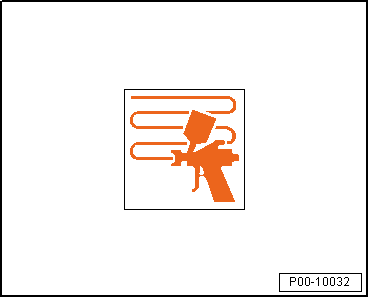
|
| |
After an appropriate final ventilation time, the clear coat
can be applied. |
 Note
| While processing the Aqua premium water-based base paint,
the spray gun material flow/trigger remains completely open. |
| For efficient ventilating and drying, stationary blowing
devices or forced drying (for example heated drying) are
recommended. |
| The spray devices should be suitable for use with
water-soluble products; see manufacturer's information. |
| The Aqua Premium mixing paints can only be used within the
color tone formulas. |
| When processing individual mixing paints on their own, major
deviations from the information given in the application
instructions are possible. |
| Rinse before and after using with Aquaplus Purified Water -LVW
010 000 A5-. Then rinse with Nitrocellulose Thinner -LVE 856 000
A3-. |
| Collect liquid waste from water-soluble products and
separate from liquid waste from conventional products. When
mixing materials, disposal may no longer be possible, which is
difficult and costly. |
|
|

|
| Personal Protective Equipment: |
| Note the safety data sheets |
| Wear the personal protective equipment during application |
|
|
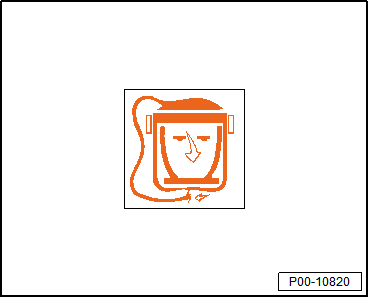
|
This universal painting system enables you to safely and
simply paint all plastic parts which can be usually found on the
exterior. (Plastic types: PP, EPDM, ABS, PC, ...
Product Description/Objective
To achieve an optically flawless color shade transition in
the blended area or adjacent parts, for example fender/door. ...
Other materials:
Volkswagen Touran Owners Manual. Start/stop system
Fig. 141 In the centre console: button
for start/stop system
First read and observe the introductory information
and safety warnings In the start/stop system, the engine will be switched
off automatically when the vehicle is stationary. When required, the engine restarts
automatically.
...
Volkswagen Touran Service Manual. Special Tools
Special tools and workshop equipment
required
Wheel Bolt Master Socket Set -T10101-
Wheel Bolt Master Socket Set -T10101A-
...
© 2016-2025 Copyright www.vwtouran.net | 0.0251


 Note
Note


 Note
Note




 Note
Note


 Note
Note
 Note
Note
 Note
Note

 Paint System for Plastic Parts
Paint System for Plastic Parts Aqua Premium System, Touch-Up System for Three Layer Colors
Aqua Premium System, Touch-Up System for Three Layer Colors
